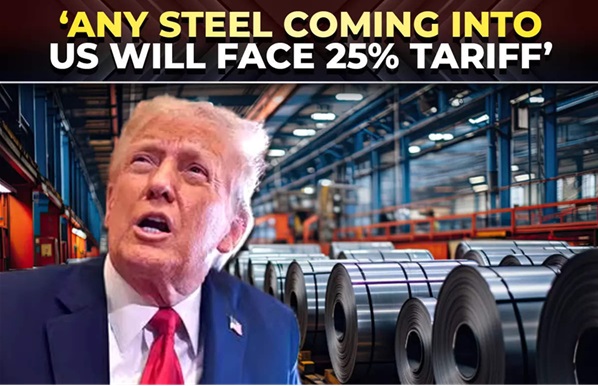Why in the NEWS?
- India fears dumping and pricing pressure due to Trump imposing 25% tariff on steel.

Key Points:
- US President Donald Trump's fresh threat to impose 25% tariff on steel and aluminium.
- Trump had imposed 25% import duty on steel and 10% on some aluminium products during his first term.
What will you read next in this topic?
- Trump's tariff threat and impact on Indian industry:
- Rise in steel imports and threat of dumping:
- Safeguard duty recommendation and government response:
- Impact on pricing and position of small producers:
- Impact on trade relations and adverse reaction:
- Fall in steel stocks and investors' reaction:
- Impact of global trade changes:
- Possible trade solutions and Indian strategies:
Trump's tariff threat and impact on Indian industry:
- US President Donald Trump's decision to impose a 25% tariff on steel during his first term was challenging for the Indian steel industry.
- The threat by Trump that he was considering imposing a 25% import duty on steel again led to concerns among Indian companies that their products would lose competitiveness and they could lose the US market.
- This threat to the US market, which is a large consumer of steel, was significant for the Indian steel industry as it is a major source of exports.
Rise in steel imports and threat of dumping:
- The US tariffs have led to a shift in the global steel trade, leading to a rise in steel imports to India.
- Imports, especially from China, are on the rise, putting Indian steelmakers under price pressure.
- There are concerns about the possibility of dumping, as China, Japan and other Asian countries have excess steel production capacity that they can export.
- This could result in dumping in the Indian market, hurting local producers.
Safeguard duty recommendation and government response:
- India's steel ministry had recommended the imposition of safeguard duty, citing an 80% increase in imports from China in 2024.
- The duty was an attempt to curb the surge in imports and protect domestic producers.
- The Indian Steel Association (ISA) also urged the Ministry of Commerce and Industry to take action against the sudden increase in import volumes since the tariffs imposed by the US President, which could pose a threat to domestic manufacturing.
Impact on pricing and position of small producers:
- Indian steel producers are facing pricing pressure in both domestic and international markets due to increased competition in the global market.
- Small Indian producers who used to sell steel at a competitive price due to low raw material costs are now facing more competition from Chinese and other Asian producers.
- This could impact their financial position.
Impact on trade relations and adverse reaction:
- The US and India already had a volatile trade relationship.
- Trump's tariff decision further strained those relations.
- Even though India had imposed tariffs on 28 items against the US, Trump's decision could result in a reduction in trade opportunities for India.
- Due to the US' trade policies, other countries may also be prompted to react.
- The European Union, South Korea and other major steel exporting countries may take action against the US decision.
Fall in steel stocks and investors' reaction:
- Shares of Indian steel companies saw a decline on Trump's tariff threat.
- Shares of Steel Authority of India (SAIL), Tata Steel, JSW Steel and Jindal Steel declined on the BSE.
- Besides, shares of steel makers globally also declined, causing concern among investors.
Impact of global trade changes:
- Trump's tariffs are likely to increase competition from countries such as the European Union, South Korea and Japan, which could impact India's steel exports.
- This could lead to trade losses for India, especially when there are changes in steel production and demand globally.
Possible trade solutions and Indian strategies:
- India now needs to improve its policy and strategies to maintain stability in the global steel trade.
- The Indian government and industries must make efforts to improve their trade relations with the US and other countries.
- The Indian steel industry must take steps to enhance the quality and competitiveness of its products so that it can maintain its position in the global market.
|
Q. Which organisation has projected that Indian steel producers will face increased challenges in 2024 due to rising US tariffs?
(a) Indian Steel Association (ISA)
(b) Moody's Ratings
(c) Federation of Indian Export Organisations (FIEO)
(d) Indian Ministry of Commerce
|



